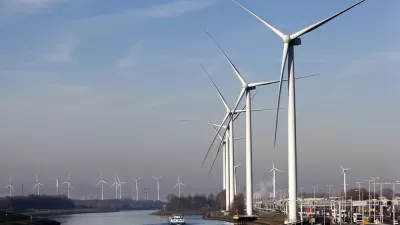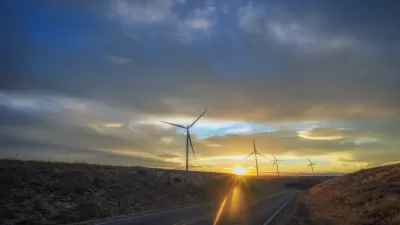Tribal communities claim that a major wind energy project threatens sensitive cultural and environmental resources.

A group of tribal communities in Washington state is suing to stop a massive wind energy project, “alleging that the decision-making process sidestepped state law and failed to mitigate potential damage to the tribe’s treaty-protected natural and cultural resources.”
As Natalia Mesa explains in High Country News, the project, which includes three solar arrays and over 200 wind turbines, extends into Yakama ceremonial sites and historically and culturally important areas. “Development would also impact the natural habitat of pronghorn and ferruginous hawks, a threatened species featured prominently in Yakama Nation ceremonies.”
The proposal has gone through several iterations after the state’s Energy Facility Site Evaluation Council (EFSEC) recommended that the developer downsize the project and take steps to mitigate any potential harms. “Tri-Cities C.A.R.E.S., a group of homeowners, and Benton County also filed lawsuits. The lawsuits are separate but similar, and they cite different concerns: Tri-Cities C.A.R.E.S. sued mainly to protect homeowners’ viewshed and property values, while Benton County contends that the project would significantly disrupt the area’s agricultural industry.”
The controversy highlights a flaw in the state’s permitting system, which doesn’t call for public and tribal consultation until after a project proposal is submitted. “Audubon, tribes and other stakeholders are currently in talks with developers and state officials, pushing for a new approach that requires consultation with tribes and local governments before projects are approved. Instead of having developers submit plans, tribal nations and local governments would establish “build-ready” sites — sites that are pre-vetted for clean energy buildout.”
FULL STORY: Tribes sue after massive wind farm in Washington gets green light

Manufactured Crisis: Losing the Nation’s Largest Source of Unsubsidized Affordable Housing
Manufactured housing communities have long been an affordable housing option for millions of people living in the U.S., but that affordability is disappearing rapidly. How did we get here?

Americans May Be Stuck — But Why?
Americans are moving a lot less than they once did, and that is a problem. While Yoni Applebaum, in his highly-publicized article Stuck, gets the reasons badly wrong, it's still important to ask: why are we moving so much less than before?

Using Old Oil and Gas Wells for Green Energy Storage
Penn State researchers have found that repurposing abandoned oil and gas wells for geothermal-assisted compressed-air energy storage can boost efficiency, reduce environmental risks, and support clean energy and job transitions.

Updating LA’s Tree Rules Could Bring More Shade to Underserved Neighborhoods
A new USC study finds that relaxing Los Angeles’ outdated tree planting guidelines could significantly expand urban tree canopy and reduce shade disparities in lower-income neighborhoods, though infrastructure investments are also needed.

California's Canal Solar Projects Aim to Conserve Resources and Expand Clean Energy
California’s Project Nexus has begun generating electricity from solar panels installed over irrigation canals, with researchers and state agencies exploring statewide expansion to conserve water and boost clean energy production.

HHS Staff Cuts Gut Energy Assistance Program
The full staff of a federal program that distributes heating and cooling assistance for low-income families was laid off, jeopardizing the program’s operations.
Urban Design for Planners 1: Software Tools
This six-course series explores essential urban design concepts using open source software and equips planners with the tools they need to participate fully in the urban design process.
Planning for Universal Design
Learn the tools for implementing Universal Design in planning regulations.
Heyer Gruel & Associates PA
City of Moreno Valley
Institute for Housing and Urban Development Studies (IHS)
City of Grandview
Harvard GSD Executive Education
Salt Lake City
NYU Wagner Graduate School of Public Service
City of Cambridge, Maryland





























